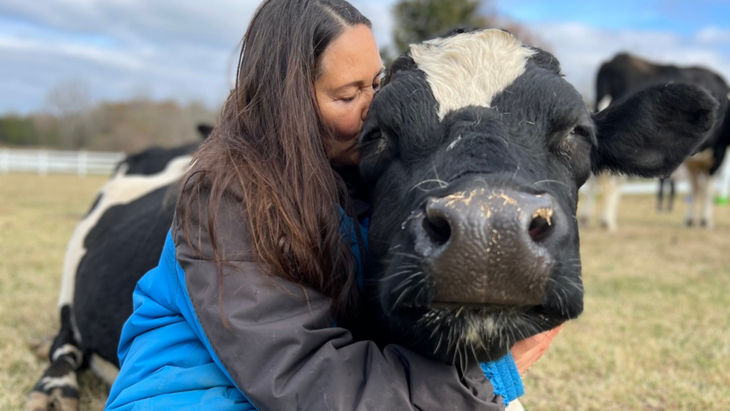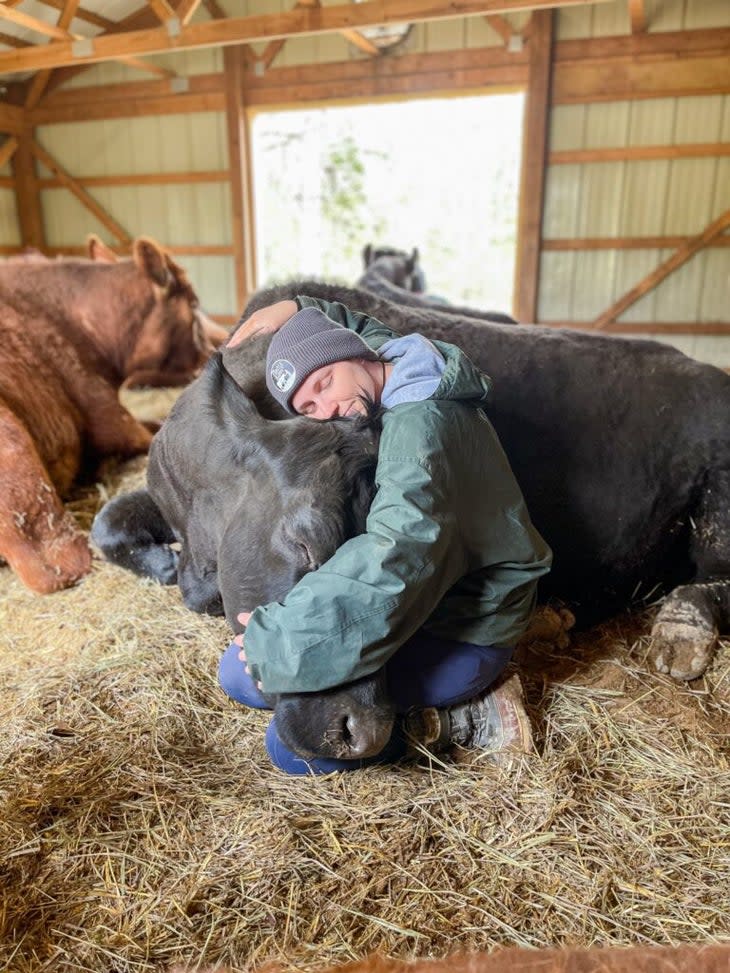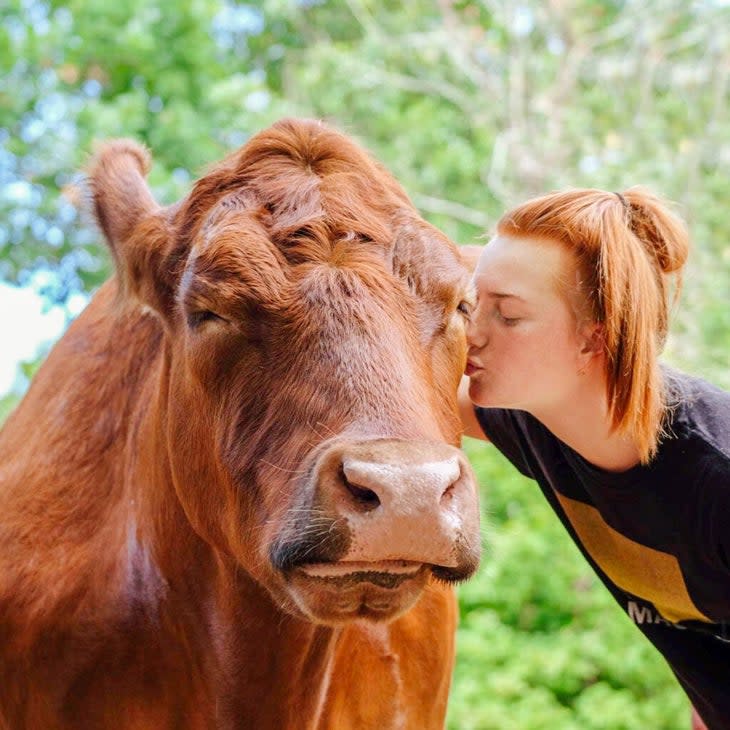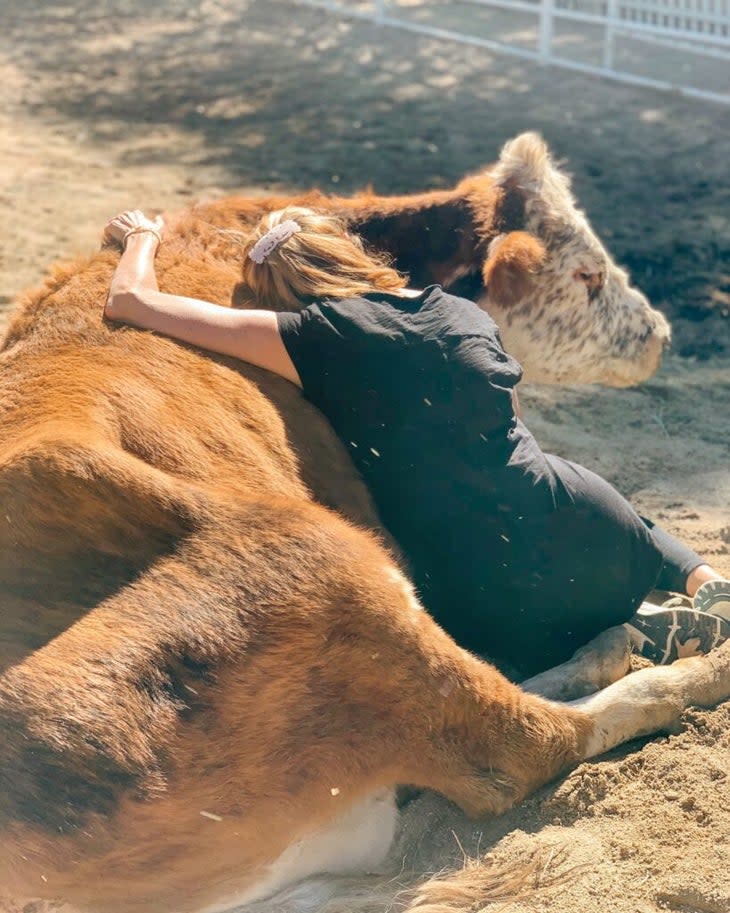Feeling Anxious? Hug a Cow – it Might Help
This article originally appeared on Outside
It's high noon in Santa Clarita when I bury my face into the side of a cow, who is lying on the ground. His fur is rich brown, the color of fertile soil, and it's silkier than I expected. I nuzzle my cheek against the animal and breathe deep. He smells sweet, like fresh hay, and musky. When I open my arms wide and grip the cow in an embrace, he shifts slightly, then eases into the weight of my body. He's holding me as much as I'm holding him.

This is cow hugging therapy, one of several animal-assisted therapies offered by the Gentle Barn, an animal sanctuary with locations in Southern California, Tennessee, and Missouri.
I realize this sounds like a joke. ( It was udderly ridiculous how many punny text messages my friends sent about this.) But I arrived at cow hugging from a sincere place—it might seem like a strange place to arrive for therapy, but after spending the past few years in a wrestling match with my own wellbeing, I was willing to try anything.
It started when I awoke in the middle of the night, my skin clammy and slick with cold sweat. My left arm was numb. My chest felt tight, as if someone was squeezing me in a bear hug I didn't want. Since I have a family history of heart disease, I drove myself directly to the ER, where I was admitted for having a possible cardiac event. Two days, many scans, and a massive hospital bill later, doctors couldn't find a single thing wrong with my heart.
But if that wasn't a heart attack, why was my heart beating so wildly? I wondered. Why did I want to pop out of my skin?
Nobody at the hospital ever broached the topic of mental health. It was my friends—those who have grappled with panic attacks themselves—who suggested that anxiety might be the root of my problem.
I've probably always struggled with some level of anxiety, but I can say with certainty that the pandemic—and the related loss and grief—exacerbated it. So ever since I ended up at the ER, I've done my best to manage with meditation, yoga, journaling, medication, and talking to my doctor, but there's still a low, anxious thrum that vibrates through me. That's what I'm trying to squelch.
Now I press my chest against a cow named Mercy. He's massive, which should be intimidating, but his sturdiness offers stability and comfort. He immediately licks my hand and nuzzles his snout on my hip. I think he chews on my sweatshirt a little.

As I hug Mercy, my right ear presses against his side, and I can hear his heartbeat, which is slower than my own. Generally, my resting heart rate is around 70 bpm, but a cow’s heart rate ranges from 48 to 84. After a moment, my pulse slows to meet Mercy's. The muscle inside my chest beats rhythmic, steady, I'd even say relaxed.
For the first time in recent memory, I am calm.
Saving Animals, Saving People
My guide to cow hugging is Ellie Laks, the founder of the Gentle Barn, which she opened in 1999. (She's married to co-founder Jay Weiner, who serves as president of the nonprofit.)
The six-acre property is located about 40 minutes outside of Los Angeles, surrounded by picturesque mountains and rolling green foothills dotted with farms. The Gentle Barn is home to an array of rehabilitated animals, like horses, goats, pigs, and turkeys, and it's open to the public on Sundays, though reservations are necessary.
Before my hugging session began, Laks walked me through the spacious cow enclosure and introduced me to each animal. I had already met Mercy, who was rescued from a veal crate at a Texas cattle ranch. But there's also Athena, a shy, black bovine with fuzzy ears, a rescue from a backyard butchery that was eventually shut down by animal control. Nudging an oversized playground ball around the yard was Faith, a dairy cow who went blind due to untreated conjunctivitis that she contracted before coming to live at the Gentle Barn. When Faith first arrived, she couldn't walk in a straight line, she only turned around in circles.
"This has always been the heart of what we do," Laks says. "We save the animals, and then the animals save us."
Animals actually trigger a chemical reaction in humans, says psychologist Veronica Hlivnenko, a holistic health counselor at InPulse. "Tactile interaction with animals induces the production of oxytocin—the chemical that promotes soothing effects, thanks to its anxiolytic properties and ability to reduce the body’s cortisol response to stress," she says. "Oxytocin acts like a neurotransmitter, meaning that when you're petting an animal, it messengers the brain to decrease the release of cortisol, alleviating the symptoms of stress and anxiety, promoting calmness and relaxation, and inducing a sense of safety and comfort."
Oxytocin is also known as the "hugging" or "cuddling" hormone, and our brain associates it with things like a loving touch and meaningful relationships. The production of this chemical inspires long-lasting positive emotional responses, which boosts our pleasure, joy, and sense of reward. All of this leads to greater levels of happiness and contentment.

As part of its mission, the Gentle Barn works with organizations for inner-city or at-risk youth, and children with special needs. That's why a significant part of the animal-assisted therapy program is rooted in sharing the animals' stories of abuse, neglect, abandonment, loneliness, and recovery.
"To know that these animals also carry their own stories of resilience, it makes people feel less alone," Laks says. "You know that if this animal can survive horrific conditions and thrive, so can you.
"Many of these kids aren't going to sit on a couch and talk to someone about their feelings, their experiences, or their trauma. But something magical happens when an animal holds you with their warmth and nurturing. It's like a big mom hug."
Holy Cow
After cuddling Mercy, I spend time with Holy Cow, who arrived at the Gentle Barn as a sickly dairy calf with significant spinal injuries. Now rehabilitated through chiropractic and veterinary treatments, this affectionate cow serves as the matriarch for the makeshift clan.
Cradling Holy Cow in the warmth of the afternoon sun, my constant thrum of worry seems to dissipate, like soap bubbles popping. I don't totally understand why this is working for me or why it feels like the most peaceful meditation I've ever done, but Laks has a few ideas.
"Cow hugging therapy has been especially instrumental in coping with grief," Laks says. "Traditional therapy works by talking about your feelings. But there's nothing to talk about with grief that allows it to be processed. It's simply pain. So it's helpful to be in a place where no words are needed, where you're just open and emotionally connecting to another being."

This is another way that animals help us, Hlivnenko says. They foster mindfulness and improve our own sense of meaningfulness. "The calming and soothing effect of petting an animal can bring your mind into a meditative state, promoting contemplation, consciousness, and reflection," she says. "Besides, animals encourage us to be our authentic selves, thus deepening our self-awareness and appreciation."
In the wake of covid, Laks opened the Gentle Barn's animal-assisted therapies to make them more accessible to adults and the general public. That means these programs are no longer exclusively for underserved youth; anyone seeking a session can make a donation and spend time with the animals.
"As a society, I believe we haven't even begun to scratch the surface of our grief and trauma from what we've just gone through. We don't have the words yet," she said. "But connecting with these gentle giants, it helps."
For exclusive access to all of our fitness, gear, adventure, and travel stories, plus discounts on trips, events, and gear, sign up for Outside+ today.

